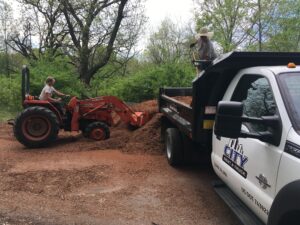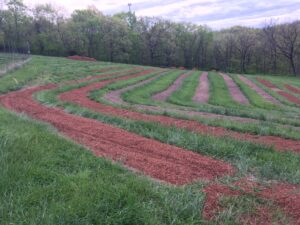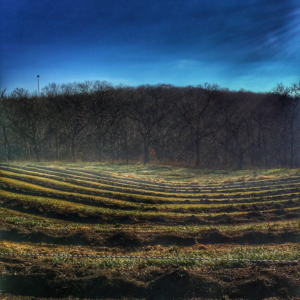Final report for FNC17-1087
Project Information
My 39.5 acres is situated in the first hills past the flood plain of the Missouri River valley in Kansas City, Kansas. It’s a beautiful piece of property with a nice home in the valley, 34.5 of the acres are forest and 5 acres are pasture. I have a pole barn close to the house for storing some equipment and equipped with a Coolbot cold storage unit which I built last summer.
In 2012 I planted 20 fruit trees in anticipation of retiring from my work at the University of Missouri, Kansas City. In 2013 I put up a 30’ x 70’ cold frame. In 2015 I planted 50 blueberry bushes and 100 elderberry bushes. In 2016 I put up a deer fence around the orchard and attached it to one side of the cold frame. In 2017 I plowed, tilled and put in a cover crop on ½ acre. Everything I’ve done is on the five acre pasture on top of the hill about 800 feet from our home and water source.
The soil is heavy loess clay. I’ve done a lot to enhance the soil in the orchard and in the cold frame. I’ve heavily mulched the trees with free wood chips from the city creating a loamy woodland soil. I have only sprayed the trees with neem oil and clay and with herbs like nettle tea and garlic. The soil around each blueberry plant is amended with 50% pine bark, 10% compost, sulfur, green sand, rock phosphate and cottonseed meal. When I put the cold frame in I had to flatten the area with a bobcat and in doing so shaved off what little top soil there was. By adding a truck load of compost, rock phosphate, green sand and microbials I’ve been able to pull a lot of vegetables from the cold frame.
In 2016 and 2017 my wife, Regina, and I grew vegetables for sale at two small farmer markets. She is an herbalist and has also developed a line of soaps and salves. She plans to incorporate blueberries and elderberries in value added products.
In fall 2016 I trenched and buried an irrigation pipe from the house which is 800 feet from the imminent blueberry field. I have improved the road up to the pasture in order to make it possible to receive mulch deliveries.
Regina and I are advocates of sustainable and organic agriculture and creating a place that our surrounding community can benefit from and enjoy. I will apply for a cost share for organic certification in several years, once the blueberry bushes start producing. Because our property is so lovely and we are in the city and only 15 minutes from Kansas City we believe we are situated well to develop a small blueberry U-pick operation and would like this to be a certified organic alternative as this is not presently an option in our area.
Our goal is to raise blueberries sustainably on ½ acre of pasture land. The soil is heavy loess clay on top of a hill. In order to produce blueberries we have amended the soil significantly. We used biochar on ¼ acre along with our usual sustainable practice using mulch and organic amendments. On the other ¼ acre we used the same practice minus the biochar.
Biochar is a type of charcoal that is produced by heating air-dried plant material (biomass) in a setting without oxygen. Biochar can store moisture and nutrients in the soil. Properly produced biochar provides a good environment for essential microorganisms to grow. These microorganisms play a major role in nutrient cycling within the soil environment. Biochar has been proven to have a significant impact when using a holistic approach to sustainable food production.
When I began this project I intended to produce the biochar on site as part of the project. I thought I had an endless source of free woodchips. That source disappeared suddenly and getting the wood chips dry enough became an issue. I found that buying the biochar was a better solution to complete the project in a timely way even though I had already bought the materials needed to produce it myself.
One problem with using biochar in blueberry production is that that biochar has a naturally high pH. This is, of course, the inverse of what is desirable when raising blueberries. Our pH is naturally 6.9. Depending on what medium is used to make the biochar the pH can be between 7-9. I solved this by washing the biochar and then mixing it with compost to charge it before adding it to the beds. The pH is presently 5.9 which is at the high end of acceptable but it does not vary from the area with the biochar so I don't think the biochar is contributing to the acidification of the soil in any way.
In Spring 2017 I plowed 1800 feet of contoured rows leaving 6 feet of turf between the beds. I left the turf between the beds to discourage erosion as the field is fairly hilly. I used a 2 bottom plow and flipped the turf downhill. Then I tilled with a 4 foot tiller driving with the back tire in the furrow. I added sulfur, rock phosphate, green sand and 100 cubic yards of pine bark mulch to the bed and tilled it in. If I did this again I would wait to see weeds and then cover the beds with black plastic until fall.
I found 16 cubic yards of compost from a local microgreen farm for free. In the fall I added 8 cubic yards to the control beds and mixed the washed biochar with the remaining 8 cubic yards of compost. The compost came in totes and after emptying 8 of them I had 16 totes to mix the biochar with the compost. After mixing I wet it down thoroughly. This activates the biochar. Then I spread it on the biochar beds and tilled it in with the 4 foot tiller.
I planted the blueberry bushes in the fall on a grid which is outlined on my attached poster. The bushes that I planted were challenged by a hot dry fall, followed by a dry warm winter, followed by an extremely cold dry early spring, followed by a hot dry late spring, summer was extreme dry and hot and we didn't get a break until late fall when we got 10 inches of rain which ended the drought. I irrigated throughout the year but still lost over half my plants and many of them struggled.
I have purchased another 250 plants which will be planted in March and will lay down an additional 75 cubic yards of free wood chips from local arborists or purchase ramial bark to add another 5 inches of mulch which I intend to spread on top of the beds for weed suppression and to gradually break down into the of the soil.
Weed suppression was an ongoing issue throughout the summer as I am not using glysophate and the pasture where I put in the blueberries has some fairly relentless grass. Over the summer I put down plastic weed mat and did a lot of hand weeding. I also tilled between the beds and planted clover and rye. I'm planning on continuing to seed the pathways between the beds. I expect the clover to improve the overall water retention but I'm not sure how it will hold up in the summer. I'm looking for something to compete with the weeds, improve the soil, mowable and that is easier to keep out of the beds than the relentless pasture grass and fescue.
The weather was extremely challenging and I didn't expect much data to report by end of this two year project as it takes six months to prepare the soil before planting blueberries and three years before harvest. I will update this report annually. My hope is to see better growth, stable pH, and better production with the plants in the biochar beds.
Our objective is to see if biochar improves blueberry growth and production. Making the biochar proved to take longer than I expected so I bought enough organically produced biochar to use at 3%. After receiving the shipment of biochar I washed it and then added it to the compost. After letting it stew for a few weeks I added it to the soil and about a month later tested the soil. Our soil pH is presently at 5.9 . I may want to bring that down a bit more and should be able to do that with iron oxide and/or sulfur.
After the study is over I will report yields and measure plant growth to determine if biochar had a significant effect. At this time I cannot report any benefits but it will be interesting to see the effects throughout the years. Blueberry bushes can live over 25 years and biochar can remain in the soil for up to 1000 years.
Research


I then used a bed shaper before planting the blueberries. The blueberries arrived in November. I planted them on a grid. There are six varieties (2 early, 2 mid season, and 2 late season). They are planted 3 feet apart.
|
Because there is only 3% biochar I don’t expect it to have any affect on the pH but I will test the soil with biochar and the soil without separately in spring 2019.
.
I've changed my mind many times about which mulch to use. I really don’t like plastic mulch and at one point decided against it. I was considering a living mulch but several studies show a lack of production. I was inundated with weed in summer 2018 so I ended up using plastic mulch but going forward will be adding either free mulch from local arborists or hardwood bark mulch (it's 1/3 the cost). In early fall 2018 I tilled between the blueberry rows and planted a cover crop of white clover. Mowing and blowing the white clover on the blueberry beds should be a good nitrogen source and the clover I picked takes foot traffic pretty well.
The 3-D electric fence seems to be working well so far and was a fairly low cost solution to keep the deer at bay and easier to maintain than the mesh I was originally planning on using.
I installed irrigation in spring 2018. I bought the system from MPR in St. Louis. It installed quickly as the emitters are built into the flexible tubing. So far it's dependable and is a much cheaper alternative to adding emitters to a line.
In spring 2019 I am adding 250 plants since half of them died due to extreme drought and heat.
In a few years I expect to see more vegetative growth and eventually better production on the blueberry bushes in the beds with the biochar. Because the weather was so challenging I cannot report any difference between the control plants and the biochar plants.
' 
The only findings I have to report at this time is that the addition of the soil amendments (primarily the sulfur and pine bark) did lower the pH 1 point.
Educational & Outreach Activities
Participation summary:
Information will be shared through our local organization, Cultivate KC. I will also share my findings on my Dogwood Forest Farm Facebook page and at the farmers markets we participate in.
I have agreed to share my information with Dr. Bayan who is the only biochar scientist in the region. He is well connected with other biochar researchers across the country. He has access to the data and knowhow generated from my experiment and will disseminate the information through Lincoln University Extension and Research via publications and workshops to train the extension trainers. Dr. Bayan also agreed to reach out to organic farmers in the central region through a website and the scientific community across the country by means of conference presentations and by publishing the project findings in journals. Unfortunately, Dr. Bayan lost his position at Lincoln. Hopefully he will still be able to share my findings but I'm not sure at this time if he will have the time or resources to do that.
At about the same time I received this grant I got a job at Johnson County Community College as the farm manager. I work closely with the Sustainable Agriculture class. I plan to present my findings at one of the sessions and do a field day with the students at my farm. There are usually around 15 students many of whom have farming projects they are presently engaged in or are planning a career in sustainable agriculture.
I already had 2 field days. One where we demonstrated and moved mulch with the tractor and dump truck and the other where we demonstrated and planted blueberries. I made events on Facebook for both events.
Next fall I plan on doing a field day, invite a local biochar enthusiast to make biochar, observe the blueberry field, and I will present my findings up to that point on the project. I will also serve blueberry crisp.
Learning Outcomes
I'm still in the early stages of the project. We just planted the blueberries. I did learn that almost everything took longer than I expected.
Project Outcomes
Not applicable at this time.
Not applicable at this time.